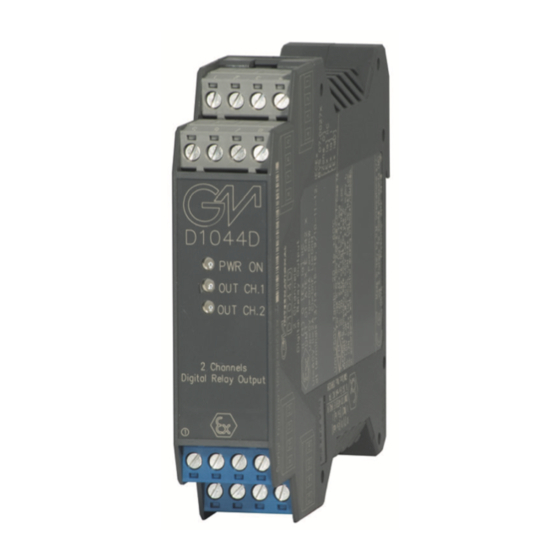Summary of Contents for GMI D1044S
- Page 1 D1044S - D1044D INSTRUCTION & SAFETY MANUAL SIL 2 - SIL 3 Digital Relay Output Loop / Bus Powered DIN-Rail Models D1044S, D1044D D1044 - SIL 2 - SIL 3 Digital Relay Output ISM0080-10...
-
Page 2: Technical Data
Characteristics General Description: The single and dual channel DIN Rail Digital Relay Output, D1044S and D1044D, are digital output modules enabling a Safe Area contact, logic level or drive signal, to control a device in Hazardous Area, providing 3 port isolation (input/output/supply). -
Page 3: Ordering Information
Power Bus enclosure Front Panel and Features SIL 2 according to IEC 61508:2010 Ed. 2 D1044S or D1044D Bus Powered mode for each channel for Tproof = 6 / 10 yrs (≤10% / >10 % of total SIF). ... - Page 4 Parameters Table In the system safety analysis, always check the Hazardous Area/Hazardous Locations devices to conform with the related system documentation, if the device is Intrinsically Safe check its suitability for the Hazardous Area/Hazardous Locations and gas group encountered and that its maximum allowable voltage, current, power (Ui/Vmax, Ii/Imax, Pi/Pi) are not exceeded by the safety parameters (Uo/Voc, Io/Isc, Po/Po) of the D1044 series Associated Apparatus connected to it.
-
Page 5: Function Diagram
Function Diagram HAZARDOUS AREA ZONE 0 (ZONE 20) GROUP IIC, SAFE AREA, ZONE 2 GROUP IIC T4, HAZARDOUS LOCATIONS CLASS I, DIVISION 1, GROUPS A, B, C, D, NON HAZARDOUS LOCATIONS, CLASS I, DIVISION 2, CLASS II, DIVISION 1, GROUPS E, F, G, CLASS III, DIVISION 1, GROUPS A, B, C, D T-Code T4, CLASS I, ZONE 2, GROUP IIC T4 CLASS I, ZONE 0, GROUP IIC MODEL D1044D Bus powered (independent channels) - Page 6 Function Diagram HAZARDOUS AREA ZONE 0 (ZONE 20) GROUP IIC, SAFE AREA, ZONE 2 GROUP IIC T4, HAZARDOUS LOCATIONS CLASS I, DIVISION 1, GROUPS A, B, C, D, NON HAZARDOUS LOCATIONS, CLASS I, DIVISION 2, CLASS II, DIVISION 1, GROUPS E, F, G, CLASS III, DIVISION 1, GROUPS A, B, C, D T-Code T4, CLASS I, ZONE 2, GROUP IIC T4 CLASS I, ZONE 0, GROUP IIC MODEL D1044D Loop powered (1oo2 channel architecture)
- Page 7 CLASS II, DIVISION 1, GROUPS E, F, G, CLASS III, DIVISION 1, GROUPS A, B, C, D T-Code T4, CLASS I, ZONE 2, GROUP IIC T4 CLASS I, ZONE 0, GROUP IIC MODEL D1044S Bus powered Supply 24 Vdc Control...
- Page 8 Energized Safety Function and Failure behavior: D1044S is considered to be operating in Low Demand mode, as a Type A module, having Hardware Fault Tolerance (HFT) = 0. The failure behaviour of D1044S is described by the following definitions: □ fail-Safe State: it is defined as the relay being de-energized (so that the NO-COM contact is open and the NC-COM contact is closed);...
- Page 9 Energized Safety Function and Failure behavior: D1044S is considered to be operating in Low Demand mode, as a Type A module, having Hardware Fault Tolerance (HFT) = 0. The failure behaviour of D1044S is described by the following definitions: □ fail-Safe State: it is defined as the relay being de-energized (so that the NO-COM contact is open and the NC-COM contact is closed);...
- Page 10 Functional Safety Manual and Applications with Bus Powered Mode and independent channels Application D1044D SIL 2 Normally Energized Relay Condition for NE Load Normal state operation De-energized to trip operation + V load + V load 13/14 9/10 13/14 9/10 Output signal Output signal ON - 24 Vdc...
- Page 11 Functional Safety Manual and Applications with Bus Powered Mode and 1oo2 channel architecture Application D1044D SIL 3 Normally Energized Relay Condition for NE Load Normal state operation De-energized to trip operation + V load + V load 13/14 13/14 PLC Output signal PLC Output signal Two relay contacts Two relay contacts...
- Page 12 Functional Safety Manual and Applications with Loop Powered Mode and 1oo2 channel architecture Application D1044D SIL 3 Normally Energized Relay Condition for NE Load Normal state operation De-energized to trip operation + V load + V load 13/14 13/14 PLC Output signal PLC Output signal Two relay contacts Two relay contacts...
- Page 13 Testing procedure at T-proof The proof test must be performed to reveal dangerous faults which cannot be otherwise detected. This means that it is necessary to specify how dangerous undetected faults, which have been noted during the FMEDA analysis, can be revealed during the proof test. The Proof test consists of the following steps.
-
Page 14: Operation
On the section “Function Diagram” and enclosure side a block diagram identifies all connections. Identify the number of channels of the specific card (e.g. D1044S is a single channel model and D1044D is a dual channel model), the function and location of each connection terminal using the wiring diagram on the corresponding section, as an example (considering a Bus Powered mode application): Connect 24 Vdc power supply positive at terminal “3”...

















Need help?
Do you have a question about the D1044S and is the answer not in the manual?
Questions and answers